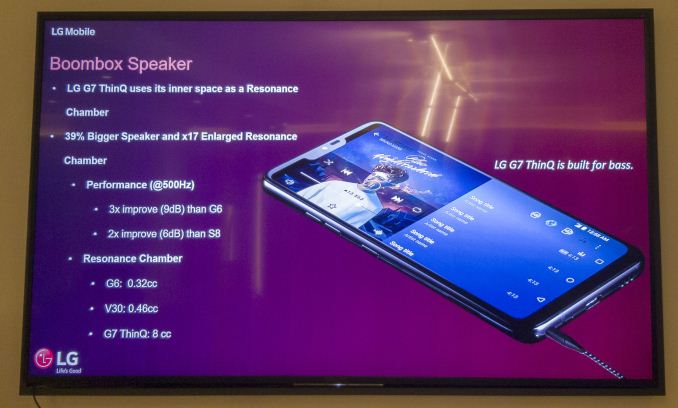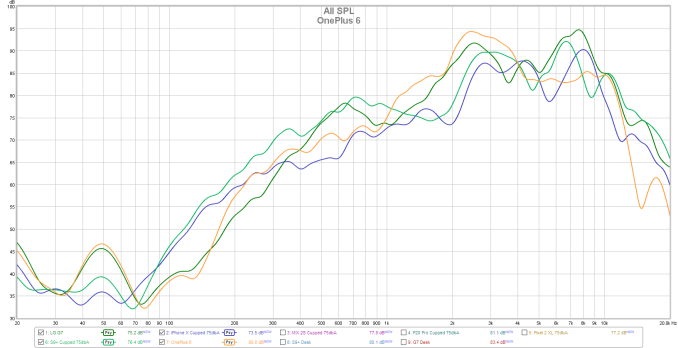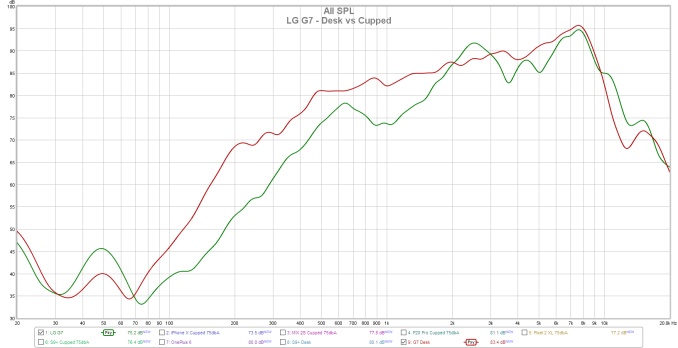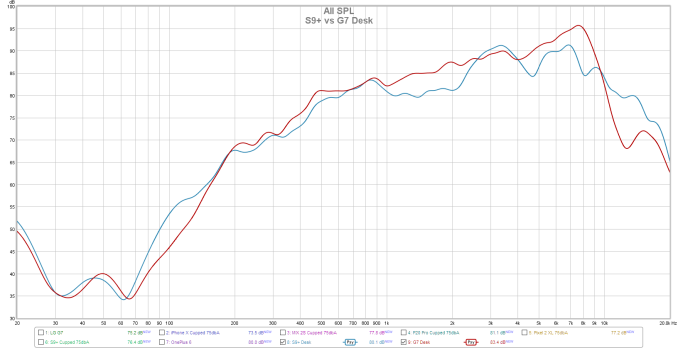The LG G7 Review: A Rushed Attempt?
by Andrei Frumusanu on August 9, 2018 11:00 AM EST- Posted in
- Smartphones
- LG
- Mobile
- LG G7 ThinQ
- LG G7
Video Recording
Video recording on the G7 is actually a very interesting topic because you have the two cameras to choose from. In terms of recording modes the phone is limited to 4K30 as its highest quality mode, while 60fps recording is enabled only for 1080p. There are also 18.9:9 aspect ratio resolutions at 2268x1080 and 1512x720 at 30fps which give you a wider field of view. EIS is only applied at 1080p30 and below.
In terms of encoding settings, the G7 only uses AVC/H.264 and doesn’t take advantage of the SoC’s more powerful HEVC encode mode. The encoding bitrates are standard for the respective resolutions and capture rates.
Main Camera:
Wide Angle:
| Recording Mode | AVC / H.264 |
| 3840p 30fps | High@L5.1 - 47.9 Mbps |
| 1080p 60fps | High@L4.2 - 24 Mbps |
| 1080p 30fps | High@L4 - 17 Mbps |
The 60fps capture modes suffer a lot from either a too low encoding bit-rate or the ISP isn’t doing as much processing, as it’s immediately visible that there’s far less dynamic range and detail compared to the 30fps modes. And it happens on both cameras.
1080p and 4K look good on both camera modules, although the lack of OIS is very visible in the wide-angle shooter. EIS functions extremely well and manages to retain a lot of detail – it’s to be noted that the occasional blurring jitter in the videos here is more of an effect of the YouTube transcoding, as the effect isn’t nearly as bad in the original video files.
What I really loved though about the G7 is the wide-angle recording in combination with EIS. I usually don’t enjoy EIS video capture because it really narrows your field-of-view too much in most cases, however on the G7 the wide-angle lens cancels out any disadvantages of the EIS, and you end up with a FOV that’s still wider than most other smartphones, with the benefit of great stabilisation.
The sound recording quality of the G7 was good, although I found that wind noise was a lot more pronounced than in other smartphones.
Overall the only larger criticism here is the loss of picture quality in the 60fps modes as well as overall the lack of being able to capture in HEVC as that would have noticeably increased picture quality without increasing file size.
Speaker Evaluation
LG made some big claims for the speaker of the G7 as it promised some really notable gains with its new design.
During our pre-brief we were presented with a few basic specs: the speaker is 39% bigger than on the G6, and also the resonance chamber is said to be the biggest of any smartphone. Instead of using the speaker housing as resonance chamber, the G7 uses the whole internal volume of the phone. This was also very much achieved thanks to the sealed nature of the phone through its IP68 rating. What this promises is vastly increased bass levels than any other phone.
First up though, let’s measure the speaker loudness. We’re using a flat response calibrated microphone and we’re measuring pink noise at a 40cm distance from the phone. The phone is held both one-handed in portrait mode, as well as two-handed with cupped palms in landscape; both of these should represent common use-cases for most people.

The results are extremely good for the G7, as it manages the loudest results among recent flagships. What is more remarkable still for the G7 is actually the directionality of the sound. Even though it only has one speaker and it’s bottom/side firing, this doesn’t seem to really hinder it much in terms of having excellent frontal directionality. I was really surprised at just how well this works and it easily outperforms even some true front-facing speakers of other phones. The sound directionality and evenness in portrait mode is particularly excellent.
Holding the phone in landscape is tougher though as it’s very much biased towards the side of the speaker and here the phone doesn’t fare as well as other stereo implementations.
Moving on to the frequency response of the speaker, we’re measuring a sweep from 20 to 20KHz, in the same conditions as our previous test, while holding the phone in landscape mode with two hands. All the phones are calibrated to the same loudness, aiming for 75dbA.
Although LG promised a lot of bass through the new speaker, it it actually ends up as one of the worst performers. The phone is significantly lacking in terms of depth, sounding very hollow. This is represented by the low SPL below 400Hz.
Investigating it more, one of the things LG did during the presentations of the phone is to showcase how the sound profile significantly changes when you lay it down on a surface. Indeed, while you hold the phone you can really feel the reverberations on the back glass of the phone. The problem here is that this is just wasted energy that doesn’t translate into any meaningful sound. Putting the phone on a standing surface allows the phone to transfer the vibrations and use the surface to amplify the sound.
I tested this out on my work desk, with once the phone held in my hand on the desk, and then again with the phone’s back flat against the desk.
Looking at the frequency response, we now see all that low frequency energy transfer to the desk and really amplify the low to mid frequencies of the phone, resulting in a much flatter frequency response.
To better represent the difference, here are two audio recordings of the two scenarios. Unfortunately I don’t have a proper omnidirectional recording microphone to capture this too well, so the recording was made with the measurement microphone – the issue with this one is that it lacks sufficient dynamic range and that’s why it sounds more muted. Here’s a recording of flat response speakers that should serve as an apples-to-apples baseline for comparison.
You can switch playback between the two recordings by pressing anywhere on the waveforms, and the recordings are synchronized in terms of their timestamps. This really represents the large audio profile difference between holding the G7 and putting it on a surface.
While this is all good in terms of looking at the frequency response, there’s a big catch when comparing the G7 to competitors. Putting the Galaxy S9+ onto the desk right next to the G7 and repeating the measurement, we actually see the Samsung phone perform even better in terms of bass as well as showcasing a significant advantage in the high frequencies.
When listening to the recording of the S9+ next to the G7, it puts the G7 into context, suddenly makes one question what the actual benefits of LG’s speaker design is. The coup de grâce for LG’s speaker is the fact that other phones don’t need to be put onto on a surface to be able so sound good; the S9+’s sound profile barely changes between holding it or putting it down. The G7 in the other hand just sounds bad when you’re holding it.
The most interesting fact is that when holding the phone, you can squeeze in the back side quite hard – what this does is reduce the internal reverberation and vibrations, and vastly increases the amplitude of lower frequencies actually coming out of the phone, noticeably improving the bass and depth of the audio.
Here’s the thing; while LG’s idea has some kind of merit and does work in some cases, a smartphone is still a handheld device, which by definition you hold it in your hand. Taking all of this into account, I don’t really see LG’s new speaker design paying off and I would even go as far to say that I somewhat prefer the G6’s sound, although that one isn’t great either.














69 Comments
View All Comments
collegsd - Friday, April 12, 2019 - link
https://bit.ly/2IpXaSM
https://bit.ly/2UyJJY6
amosbatto - Wednesday, August 22, 2018 - link
There is not a single smartphone on the market that I want to buy, because I want three features:3.5mm audio jack, dual front facing speakers and a removable battery.
19.5:9 screens and bezelless design offers nothing useful in my opinion.
I really hate being forced to buy a new phone, just because the battery no longer holds a decent charge after 500 discharge cycles. I really wish that tech reviewers would talk about how hard it is to replace the battery and how well the phone is designed to survive drops. I could care less about CPU benchmarks, compared to how long the phone will last.
eastcoast_pete - Friday, August 24, 2018 - link
Well, I am in your boat. Recently decided to go back to the future, bought a new-in-box V20 with warranty for about $ 250 with taxes, added a big ass replacement battery with (claimed) 6800 mAh (vs. the 3200 stock) for about $30, and - so far, so good. The phone is bulky, due to its necessary bigger replacement back, but I am Ok with that. Battery seems to be living up to its specs (6 weeks in), easily get 2 days of full use, despite Snapdragon 820 and bright screen setting. Wish many of the LG apps would be better or could be uninstalled or at least disabled, but the V20 seems to be as good as it gets if one wants a 16:9 screen, a removable battery, and decent phone performance. I suggest LG also goes "back to the future" and makes the next V phone (V40?) with a removable battery once again - there is a market there that Samsung is not serving.Ultraman1966 - Tuesday, September 18, 2018 - link
You can't use the biggest disappointment twice in the review when it lists two different things!!!al3xisss - Tuesday, October 2, 2018 - link
Do you know if they have pushed a software update to fix the display and camera calibration?Archipelago - Thursday, October 4, 2018 - link
Thanks for the great review. The wide angle camera is a critical feature for me. I have a V20 and a G6 and was hoping that the G7 would be my next phone, a phone with a better camera than the G6. I guess I will hold on to the G6. I too hope that LG will have a software fix for the camera problems, but I am dubious. LG seems to produce, sell and forget.joser0913 - Saturday, December 29, 2018 - link
I think this is a very fair review for the G7. I've had it for 1 week and almost all the reviews are accurate. I just want to mention one thing that I think should have been mentioned in the conclusions of the review. Is this phone better for audiophiles? That is a point of sale for some people and should have been directed properlyIn addition, he did not mention the DTS: X 3D Surround function, which can be enjoyed in some scenarios (movies and some games).
Hrel - Monday, January 28, 2019 - link
I can't believe you test Huawei but not Sony smartphones. Sony makes the best value smartphones period, review them.Sakisucc - Sunday, February 3, 2019 - link
The audio recordings from LG G7 Fit are total crap. There are lack of bass and mid frequencies. Same problem is in Video records. Too much only high trebles and noise, pair this with too aggressive noise reduction and you have just unusable sound.I must sell that phone is ASAP